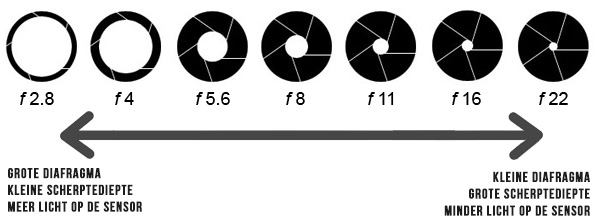Aperture, ISO & Depth Of Field Camera settings for stop motion
Video is basically a sequential series of photos. As a videographer you must be familiar with the same techniques and terms as a photographer, especially when making stop motion.
If you have knowledge of; Aperture, ISO and DOF you will use the correct camera settings during scenes with difficult lighting conditions.

In this post we'll cover:
Aperture (aperture)
This is the opening of the lens, it is indicated in F value. The higher the value, for example F22, the smaller the gap. The lower the value, for example F1.4, the larger the gap.
In low light, you will open the Aperture further, i.e. set it to a lower value, to collect enough light.
At a low value you have less image in focus, at a higher value more image in focus.
In controlled situations a low value is often used, with a lot of movement a high value. Then you have fewer problems with focusing.
ISO
If you are filming in a dark situation, you can increase the ISO. The disadvantage of high ISO values is the inevitable noise formation.
The amount of noise depends on the camera, but lower is basically better for image quality. With a film, one ISO value is often determined and each scene is highlighted at that value.
Depth of Field
As the Aperture value decreases, you will get a progressively smaller distance in focus.
With a “Shallow DOF” (superficial) depth of field, a very limited area is in focus, with a “Deep DOF / Deep Focus” (deep) depth of field, a large part of the area will be in focus.
Getting started with your own stop motion storyboards
Subscribe to our newsletter and get your free download with three storyboards. Get started with bringing your stories alive!
We'll only use your email address for our newsletter and respect your privacy
If you want to emphasize something, or clearly disconnect a person from the background, use a Shallow Depth of Field.
Besides the Aperture value, there is another way to reduce the DOF; by zooming in or using a long lens.
The further you can optically zoom in on the object, the smaller the sharp area becomes. It is useful to place the camera on a tripod (best for stop motion reviewed here).

Practical tips for stop motion
If you’re making a stop motion movie, a high Aperture value in combination with as little zooming as possible or using a short lens is the best way to record sharp images.
Always pay attention to the ISO value, keep it as low as possible to prevent noise. If you want to achieve a movie look or a dreamy effect, you can lower the Aperture for a shallow depth of field.
A good example of high Aperture in practice is the movie Citizen Kane. Every shot is completely sharp there.
This goes against conventional visual language, director Orson Welles wanted to give the viewer the opportunity to view the entire image.
Hi, I'm Kim, a mom and a stop-motion enthusiast with a background in media creation and web development. I've got a huge passion for drawing and animation, and now I'm diving headfirst into the stop-motion world. With my blog, I'm sharing my learnings with you guys.
